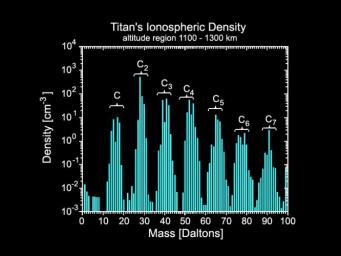
|
Titan’s Upper Atmosphere: A “factory” of hydrocarbons
- Click the image above for a larger view
- Full-Res JPEG (720 x 540) (49.8 kB)
- Full-Res TIFF (720 x 540) (1.2 MB)
Caption:
During its closest flyby of Saturn's moon Titan on April 16, the Cassini spacecraft came within 1,025 kilometers (637 miles) of the moon's surface and found that the outer layer of the thick, hazy atmosphere is brimming with complex hydrocarbons.
This figure shows a mass spectrum of Titan's ionosphere near 1,200 kilometers (746 miles) above its surface. The mass range covered goes from hydrogen at 1 atomic mass unit per elementary charge (Dalton) to 99 Daltons. This mass range includes compounds with 1, 2, 3, 4, 5, 6, and 7 carbons as the base structure (as indicated in the figure label). The identified compounds include multiple carbon molecules and carbon-nitrogen bearing species as well.
Background Info:
The Cassini-Huygens mission is a cooperative project of NASA, the European Space Agency and the Italian Space Agency. The Jet Propulsion Laboratory, a division of the California Institute of Technology in Pasadena, manages the mission for NASA's Science Mission Directorate, Washington, D.C. The Cassini orbiter was designed, developed and assembled at JPL. The ion and neutral mass spectrometer team is based at University of Michigan, Ann Arbor.
For more information about the mission visit http://saturn.jpl.nasa.gov .
Cataloging Keywords:
| Name | Value | Additional Values |
|---|---|---|
| Target | Titan | |
| System | Saturn | |
| Target Type | Satellite | |
| Mission | Cassini-Huygens | |
| Instrument Host | Cassini Orbiter | |
| Host Type | Orbiter | |
| Instrument | Ion and Neutral Mass Spectrometer (INMS) | |
| Detector | ||
| Extra Keywords | Atmosphere, Color, Haze | |
| Acquisition Date | ||
| Release Date | 2005-04-22 | |
| Date in Caption | ||
| Image Credit | NASA/JPL/University of Michigan | |
| Source | photojournal.jpl.nasa.gov/catalog/PIA07865 | |
| Identifier | PIA07865 | |
